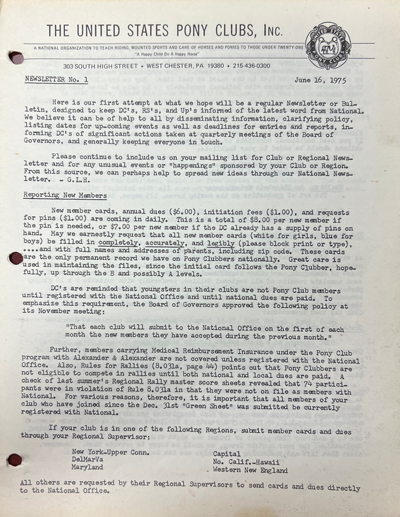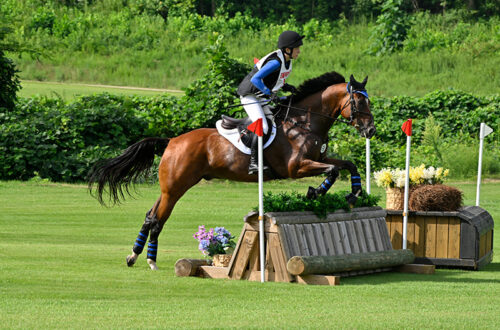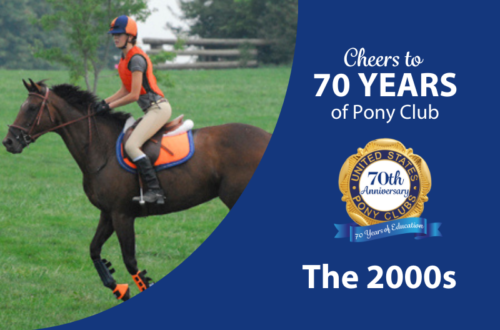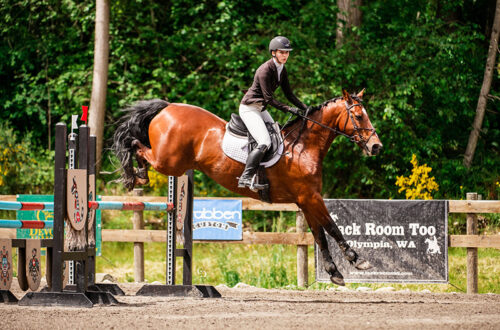
Evolution of USPC’s Publication: From the First USPC Newsletter to the Official Magazine
By Sarah Evers Conrad, USPC Marketing and Communication Director
With the 70th Anniversary of the United States Pony Clubs this year, I’ve been able to read some fascinating materials from our archives as the Marketing Department prepares fun blogs and social media posts as members help us celebrate the anniversary. We’re so lucky that USPC staff over the years has been so committed to its history and preserving documents, files, and past publications here at the National Office. Since I’m the magazine editor, I was curious about the history of the magazine.
At one point, the Chronicle of the Horse was the official publication for the United States Pony Clubs, and clubs and regions would send reports to Chronicle staff to print. I’ve seen a variety of clippings from over the years, and it’s really fun to read all the names of participants, and even be able to recognize some of them.
In addition to the Chronicle printing Pony Club news well into the 1970s, USPC staff also decided to start offering a continuous newsletter. Now there were a few offered in the 1960s, but it was really in the 1970s that it would become continuous (from what I can tell from the archives). Based on the number of the issues, this newsletter would eventually evolve into the Pony Club News magazine, and then be renamed a few years ago to Discover USPC magazine. (We truly hope readers are enjoying the magazine as it evolves today. If you would like to email any feedback on it, please feel free to do so at marketing@ponyclub.org.)
These newsletters grew slowly over the years from a folded four-page newsletter to more and more pages, until it eventually became a full-fledged full-color magazine. However, with that first four-page edition published in June 1975, I wanted to share some tidbits I found interesting about the news it shared. And then I found additional information to share beyond that first newsletter, which is also below.
They’ve been so fun to read, and they are all filled with so many happenings, but unfortunately there is no way to share everything, unless I had the time to become a part-time historian. So, I’ll try to share the highlights for each decade as we go decade by decade sharing important snippets from USPC’s very extensive history. Stay tuned to the USPC History category on the blog.
The information in the first Pony Club newsletter in June 1975 shared the following:
- The cost of annual dues were $6.00 back then (which is $35.03 today), plus an initiation fee of $1.00 ($5.84 today) and pins that cost $1.00 ($5.84 today, which is actually more than they cost in today’s money). Life Membership cost $250 ($1,459.43 today, however now we only charge $1,000).
- The National Office sold a variety of publications, including Rules for Pony Club Tetrathlon, Vaulting by Elizabeth Friedlaender, and The Literature of Equitation by W. Sidney Felton.
- The Chronicle of the Horse had already been the official publication of USPC for many years, and as such, has provided excellent coverage of all Pony Club events, both local and national. It also published Regional Rally dates, minutes of all meetings of the Board of Governors, and other significant USPC news.
- The 1975 National 5-Phase Rally was July 29-August 1 in Lake Placid, N.Y. The National Games Rally was August 8-10 at the Ashland Fair Grounds in Ashland, Ohio. The National Tetrathlon Championships were August 15-17 at Kent School in Kent, Conn., and would be there for several years afterward.
- Less traditional disciplines in Pony Club activities included Tetrathlon, Polo, Competitive Trail Riding, Vaulting, and “know-downs” or quiz competitions.
- After Alice Reidy, the secretary was Anne Feine, who joined the staff in July 1974. However, she left to have her first child by June of 1975. Next was Corky Ross Mann, a graduate A from Millbrook Pony Club, who also joined Jeannie McAleer, another graduate A from Pickering Hunt Pony Club.
- The first National Tetrathlon Championship attracted 13 boys with an age range of 13-20 and a median age of 16.
The newsletter was well-received and expanded to quarterly in March 1976 for DCs and Up and for Life and Sustaining Members.
- In 1976, there were 54 tests for certifications, 43 (19 one-day, 24 two-day) for B candidates and 11 for A candidates. Successful B candidates numbered 251, bringing the total number of active Bs on record for 1975 to 956 (110 of them boys). Successful A candidates numbered 51, bringing that list for 1975 to 81 (13 of them boys). Fifty-two clubs were represented by As.
- In 1977, the H-A rating (now called certification) was added as a new step required of Bs before they could apply for an A testing, which consisted entirely of the non-riding aspects of the A level and includes two full days of examination in stable management, veterinary knowledge, longeing, teaching, and other areas of horsemastership. Those achieving the H-A, and who then applied for the next test, would go on to be tested in riding only for the A certification. Nine H-A tests were held, with 77 of 103 candidates (75%) passing.
- Show Jumping was added in 1978 with the comment: “A committee has been formed to develop and oversee this activity, which is new to USPC but has been a popular British Pony Club activity for a number of years.” Six regions held competitions the first year, and the committee hoped to have final rules in place by the 1979 rally season.
- Disciplines that added committees by 1978 include:
- Combined Training (started as the original discipline in USPC from 1954 onward)
- Dressage: 1962
- Polo: 1962
- Mounted Games: 1963
- Foxhunting: 1966
- Equestrian Trails: 1968
- Tetrathlon: 1973
- Vaulting: 1977
- Show Jumping: 1978
- Driving: 1979
- Know-Down: 1979
- Horse Management: 1979
- The Headgear Committee was begun in 1971 as USPC started to look at helmet safety.
- In 1976, the Visiting Instructors Committee was started with Jessica Ransehousen as Chair to help facilitate a program that allowed for experienced USPC instructors to be requested by clubs or regions to teach members based on various topics at clinics and workshops. The Visiting Instructors program ran until 2023.
- In the 1970s, there was the Working Student Program, which was a summer program to help channel interested, motivated Pony Club members to positions where they could further their knowledge and experience. The program was geared toward the A-, H-A-, and B-level members, although mature C-2 members were considered. They wanted to match employer needs with the summer employment expectations of Pony Club members. Employment is usually in return for experience, instruction, room and board of the member and/or their horse, and occasionally pocket money.
- On March 11-12, 1978, the first Instruction Council meeting was held in West Chester, PA, and the Council began developing specific D-1, D-2, D-3, and C-1, C-2, and C-3 Levels of Proficiency. The goal was to review and redefine the standards for Ds and Cs and to develop a new set of standards for the B, H-A, and A levels that will clarify for all candidates, DCs, instructors, and parents, the level of proficiency required for testing. In addition, lesson plans were being created for untested members, Ds, and Cs in all subjects within the Levels of Proficiency.
- In 1978, the Competitions Council was renamed to the Activities Council. Representatives from the Foxhunting, Vaulting, Driving, and Camp Committees joined the Council, which was chaired by John H. Fritz. The Council already oversaw the traditional competitive Pony Club activities of Combined Training, Games, and Dressage. In 1978, there were:
- 23 B/C Regional Combined Training Rallies
- 10 Regional Dressage Rallies
- 6 Regional Show Jumping Rallies
- 13 Regional Games Rallies
- 6 Regional Tetrathlon Rallies
- Innumerable Know-Downs
- 1 National Combined Training Rally with 16 B Teams and 9 As
- 1 Inter-Regional Competitive Trail Ride
- 1 Inter-Regional Games Rally with 22 Teams
- 1 Inter-Regional Show Jumping Competition
- 3 Inter-Regional Dressage Competitions
- As of the publication of USPC’s first Annual Report (what we now call the USPC Annual Directory) in 1956, there were 9 regions, 38 clubs, and 1,939 members. As of USPC’s 25th anniversary in 1979, there were 24 regions, 322 clubs, and 10,257 members.
- In 1979, new standards had been implemented and the first crop of C-3s became a reality. More than 300 B candidates will have been tested at 39 test sites. H-A candidates number 140 in 11 tests, while 11 tests will also be held for the anticipated 120 A candidates.
- Back in 1979, it was noted that Australia had the largest membership of any pony Club organization with 669 branches and 25,000 members.
- National Office staff in 1979 included:
- Jeannie Knowlton, one of three McAleer sisters who were all As. Jeannie, herself a National Examiner, was involved in the administration of the testing program since the National Office first moved to West Chester in 1974. She has also handled the book department and was a master package wrapper.
- Janet Brubaker, a one-time math major, with a BS in Animal Science, was the bookkeeper and handled membership and insurance. She was also a British Horse Society Assistant Instructor (BHSAI), had studied under numerous top dressage instructors, and had taught theory and activity courses in the Equestrian Studies programs of the University of Massachusetts and William Woods College, Mo. A USPC National Examiner, Jan enjoyed competing on her spare weekends in local dressage and combined training competitions.
- Margot Sachey, a graduate A and a National Examiner, spent five years as Assistant Director of a family-owned riding school on Long Island. There she helped write and direct a state-licensed Assistant Instructors Course, teaching theory, stable management, and riding. She held an American Horse Shows Association (AHSA, now the United States Equestrian Federation or USEF) judges license in hunters and jumpers and hunter seat equitation. Margot filled the new position of USPC Coordinator of Instruction and Testing, designed to ease the burden of the Instruction Council. She sorts out candidates for B, H-A, and A tests, appointed National Examiners for the tests, and followed up on results. She also launched a countrywide search for knowledgeable horsemen and horsewomen who could become National Examiners. Margot also planned to update and supplement the current list of educational materials available to Pony Club members and their instructors.
I hope you enjoyed this look at Pony Club’s first newsletter. If there are any questions you have about USPC’s history that I can keep an eye out for the answers as I dig through our history, feel free to email me at marketing@ponyclub.org. I’d love to know what you all are interested in reading about.





